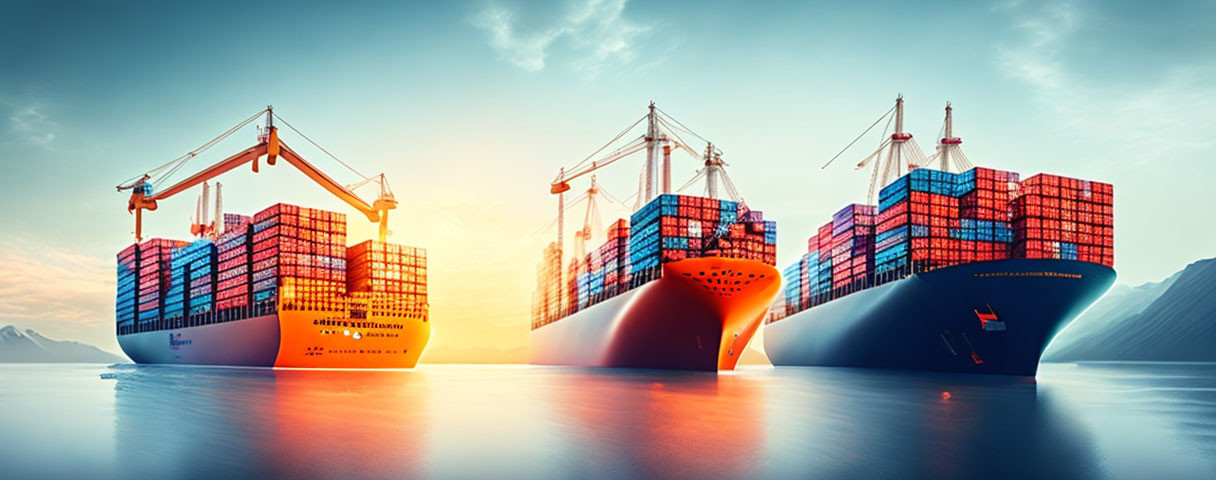
RESHAPING THE GLOBAL SUPPLY CHAIN: INNOVATIONS AND STRATEGIES FOR A MORE RESILIENT BUSINESS FUTURE
I. Introduction
Global supply chain refers to the interconnected network of suppliers, manufacturers, intermediaries, and logistics providers that work together to deliver goods and services to customers worldwide. It involves the movement of raw materials, finished products, and information across multiple geographies, languages, and cultures.
The importance of global supply chains in business operations cannot be overemphasized. Many companies depend on global supply chains to access new markets, reduce production costs, improve product quality, and enhance customer satisfaction. However, the COVID-19 pandemic has exposed the vulnerabilities of global supply chains, such as disruptions, delays, and shortages caused by border closures, travel restrictions, and lockdowns.
To address these challenges, there is a need for innovations and strategies in reshaping the global supply chain. This blog will explore some of these innovations and strategies, and how they can help businesses build a more resilient future.
In the next section, we will discuss the impact of the COVID-19 pandemic on the global supply chain, and why businesses need to rethink their supply chain strategies in response to the crisis.
II. Impact of COVID-19 in the Global Supply Chain
The COVID-19 pandemic has caused unprecedented disruptions in the global supply chain. The sudden outbreak of the virus in late 2019 and its rapid spread around the world have forced many businesses to rethink their supply chain strategies.
A. Disruptions brought by the Pandemic
One of the most significant disruptions brought by the pandemic is the closure of borders and travel restrictions. This has affected the movement of goods, especially those that require air or sea transport. Many ports and airports around the world have been closed or severely restricted, leading to delays and cancellations of shipments.
Another disruption is the shortage of raw materials and finished products. The pandemic has caused disruptions in the production and distribution of goods, leading to shortages of critical items such as personal protective equipment (PPE) and medical supplies. Many companies have also experienced disruptions in their workforce due to quarantine measures, illness, and fear of contagion.
B. Lessons Learned from COVID-19 Crisis
The COVID-19 crisis has highlighted the need for businesses to be more resilient in the face of unexpected challenges. One lesson is the importance of diversifying the supply chain. Companies that had alternative suppliers or production sites were better able to manage the disruptions caused by the pandemic.
Another lesson is the need for transparency and visibility in the supply chain. Companies that had real-time information on their suppliers, inventory levels, and transportation routes were better able to anticipate and respond to disruptions.
C. Innovations and Strategies Adopted by Successful Companies
Some companies have been successful in adapting to the challenges brought by the pandemic by adopting innovative strategies. One strategy is the use of digital technologies to enhance supply chain visibility and agility. For example, companies have used artificial intelligence (AI) and machine learning (ML) to forecast demand, optimize inventory levels, and manage logistics.
Another strategy is the adoption of circular economy principles to reduce waste and create more sustainable supply chains. Companies are exploring ways to reuse, repair, and recycle products and materials to reduce their environmental impact and increase resilience.
In the next section, we will discuss some of the innovations and strategies that companies can adopt to build a more resilient global supply chain.
III. Innovations and Practices in Shaping the Future of Global Supply Chain
The COVID-19 pandemic has accelerated the adoption of new technologies and practices in the global supply chain. Companies are exploring innovative ways to enhance supply chain resilience, efficiency, and sustainability. In this section, we will discuss some of the key innovations and practices that are shaping the future of the global supply chain.
A. Artificial Intelligence and Advanced Data Analytics
Artificial Intelligence (AI) and advanced data analytics have become essential tools in the global supply chain. They enable companies to collect and analyze vast amounts of data in real-time, providing insights that can inform better decision-making. AI and data analytics can help companies optimize inventory levels, predict demand, and manage logistics more efficiently. They can also enable companies to identify and mitigate potential disruptions before they occur.
B. Internet of Things (IoT) and Robotics
The Internet of Things (IoT) and robotics are transforming the global supply chain by enabling real-time monitoring and control of goods and assets. IoT sensors can provide real-time information on the location, condition, and status of goods, helping companies to track and manage their inventory more effectively. Robotics can automate many aspects of the supply chain, such as picking and packing, reducing costs and increasing efficiency. Autonomous vehicles and drones are also being explored as a means of delivering goods more quickly and efficiently.
C. Blockchain Technology
Blockchain technology is being explored as a means of improving supply chain transparency, traceability, and security. Blockchain can enable companies to track their products from the source to the destination, providing a tamper-proof record of each transaction. This can help companies to identify and address any issues that arise in the supply chain, such as counterfeiting or theft.
D. Sustainability and Eco-Friendliness
Sustainability and eco-friendliness are becoming increasingly important considerations in the global supply chain. Companies are exploring ways to reduce waste, minimize their carbon footprint, and promote ethical and responsible practices. This includes the use of sustainable materials, the adoption of circular economy principles, and the promotion of fair labor practices.
E. Automated and Drone Deliveries
Automated and drone deliveries are being explored as a means of improving the speed and efficiency of last-mile delivery. Autonomous vehicles and drones can navigate traffic and deliver goods more quickly than traditional delivery methods, reducing costs and increasing customer satisfaction. They can also help to reduce carbon emissions and traffic congestion in urban areas.
In the next section, we will discuss some of the challenges and risks associated with reshaping the global supply chain.

IV. Strategies for Responding to Future Disruptions
The COVID-19 pandemic has exposed the vulnerabilities and risks in the global supply chain. Companies are realizing the need for strategies to respond to future disruptions and build greater resilience. In this section, we will discuss some of the key strategies that companies can adopt to respond to future disruptions.
A. Crisis Management Planning
Crisis management planning involves developing a comprehensive plan to respond to various types of disruptions, such as natural disasters, cyber-attacks, and pandemics. The plan should include protocols for communication, decision-making, and resource allocation. It should also involve regular testing and updating to ensure that it remains relevant and effective.
B. Diversification and Localization of Supply Chains
Diversification and localization of supply chains involves reducing dependence on a single source of supply or geographic location. Companies can achieve this by developing alternative sources of supply, building redundancy into their supply chains, and investing in local suppliers and production facilities. This can help to mitigate the impact of disruptions in one region or from one supplier.
C. Building Stronger Collaborations with Suppliers and Customers
Building stronger collaborations with suppliers and customers involves developing closer relationships and greater transparency in the supply chain. This can involve sharing information, developing joint planning and decision-making processes, and building trust and mutual understanding. Stronger collaborations can help to improve responsiveness, agility, and innovation in the supply chain.
D. Implementing Sufficient Risk Management Measures
Implementing sufficient risk management measures involves identifying and mitigating risks in the supply chain. This can involve conducting risk assessments, developing contingency plans, and investing in risk mitigation measures such as insurance and financial hedging. Companies can also implement technologies and practices that improve supply chain visibility and traceability to identify and respond to risks more quickly.
In summary, reshaping the global supply chain requires not only innovations but also robust strategies for responding to future disruptions. Companies can adopt crisis management planning, diversification and localization of supply chains, stronger collaborations with suppliers and customers, and sufficient risk management measures to build greater resilience and agility in the supply chain. In the next section, we will discuss the importance of sustainability in reshaping the global supply chain.
V. Case Studies: Successful Adoptions of Strategy and Innovation to Reshape the Global Supply Chain Post-COVID-19
The COVID-19 pandemic has presented an opportunity for companies to reshape their global supply chains. In this section, we will discuss some of the successful adoptions of strategy and innovation by companies to reshape their supply chains post-COVID-19.
A. Amazon.com
Amazon.com, the world's largest online retailer, has been able to maintain its supply chain operations amidst the pandemic. To adapt to the changing consumer demands, Amazon has opened new distribution centers and increased its delivery capacity. Amazon has also implemented safety measures such as social distancing and temperature checks to protect its workforce.
B. DHL
DHL, the world's largest logistics company, has been able to maintain continuity in its supply chains during the pandemic. DHL has developed a digital platform that provides real-time visibility of shipments, enabling customers to adjust their supply chain operations in response to disruptions. DHL has also implemented measures such as contactless delivery and temperature checks to ensure the safety of its employees.
C. Coca-Cola
Coca-Cola, the world's largest beverage company, has implemented measures to diversify its supply chain and reduce dependence on a single source of supply. Coca-Cola has invested in local production facilities and suppliers to ensure continuity in its supply chain operations. Coca-Cola has also implemented measures such as social distancing and remote work to ensure the safety of its employees.
D. Nokia
Nokia, the Finnish multinational telecommunications company, has implemented measures to improve supply chain visibility and traceability. Nokia has adopted blockchain technology to provide real-time visibility of its supply chains, enabling it to identify and respond to risks more quickly. Nokia has also implemented measures such as safety protocols and contingency planning to ensure the continuity of its supply chain operations.
E. Walmart
Walmart, the world's largest retailer, has implemented measures to improve supply chain efficiency and responsiveness. Walmart has invested in automation technologies such as robots and AI to improve the speed and accuracy of its supply chain operations. Walmart has also implemented measures such as contactless delivery and curbside pickup to ensure the safety of its customers and employees.
In summary, companies such as Amazon.com, DHL, Coca-Cola, Nokia, and Walmart have successfully reshaped their global supply chains post-COVID-19 through innovation and the adoption of new strategies. These case studies demonstrate the importance of agility, diversification, collaboration, and risk management in building a more resilient supply chain. In the next section, we will discuss the role of technology in reshaping the global supply chain.
VI. Conclusion
The COVID-19 pandemic has highlighted the vulnerabilities and weaknesses of the global supply chain. Companies have had to quickly adapt to the changing circumstances by adopting new strategies and innovations to ensure the continuity of their supply chain operations.
A. Importance of Reshaping the Global Supply Chain
The pandemic has shown that the global supply chain needs to be reshaped to become more resilient, sustainable, and innovative. Companies need to collaborate with their suppliers, customers, and stakeholders to develop a more agile and responsive supply chain. They need to diversify their sources of supply and invest in local production facilities to reduce dependence on a single source of supply.
B. Effect of Innovation and Strategy on the Future of Global Supply Chains
Innovation and strategy are critical to the future of global supply chains. Companies that invest in new technologies and explore new business models will be better placed to adapt to the changing circumstances and seize new opportunities. They need to embrace digitalization, automation, and AI to improve the efficiency and transparency of their supply chain operations.
C. Practical Measures to Ensure a Sustainable, Resilient and Innovative Global Supply Chain
To ensure a sustainable, resilient, and innovative global supply chain, companies need to take practical measures such as:
- Collaborating with suppliers, customers, and stakeholders to develop a more agile and responsive supply chain.
- Diversifying sources of supply and investing in local production facilities to reduce dependence on a single source of supply.
- Embracing digitalization, automation, and AI to improve the efficiency and transparency of their supply chain operations.
- Implementing measures such as safety protocols, contingency planning, and remote work to ensure the continuity of their supply chain operations.
- Investing in the development of a skilled and adaptable workforce that can respond to the changing circumstances.
In conclusion, the COVID-19 pandemic has presented an opportunity for companies to reshape their global supply chains. It has highlighted the need for agility, diversification, collaboration, and risk management in building a more resilient and sustainable supply chain. Companies that invest in innovation and new strategies will be better placed to adapt to the changing circumstances and seize new opportunities.
Unlocking Your Success: Essential Links for Savvy Buyers and Sellers
When you click on these links, rest assured that you will not be charged any extra amount for your purchases. However, it's worth mentioning that if you make a successful purchase through these links, we may earn a commission as a part of the Amazon Associates program.
By using these affiliate links, you can support our website and the content we provide, enabling us to continue bringing you valuable information and resources. Your support means the world to us, and it allows us to keep serving you with the best content possible.
We want to be fully transparent with our audience, and that's why we disclose that some of the links on our website are affiliate links. Your trust and satisfaction are of utmost importance to us, and we will always strive to maintain that trust by recommending products and services that we genuinely believe will benefit you.
Thank you for being a part of our community and for supporting us through your purchases. Happy shopping!


